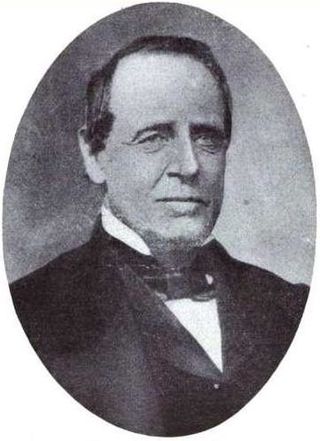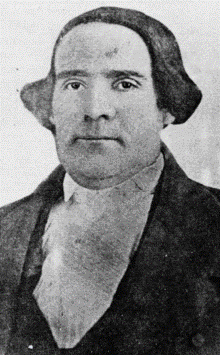
The Compromise of 1850 was a package of five separate bills passed by the United States Congress in September 1850 that temporarily defused tensions between slave and free states in the years leading up to the American Civil War. Designed by Whig senator Henry Clay and Democratic senator Stephen A. Douglas, with the support of President Millard Fillmore, the compromise centered on how to handle slavery in recently acquired territories from the Mexican–American War (1846–48).

The Territory of New Mexico was an organized incorporated territory of the United States from September 9, 1850, until January 6, 1912. It was created from the U.S. provisional government of New Mexico, as a result of Nuevo México becoming part of the American frontier after the Treaty of Guadalupe Hidalgo. It existed with varying boundaries until the territory was admitted to the Union as the U.S. state of New Mexico in 1912. This jurisdiction was an organized, incorporated territory of the US for nearly 62 years, the longest period of any territory in the contiguous United States.

The Territory South of the River Ohio, more commonly known as the Southwest Territory or the old Southwest Territory, was an organized incorporated territory of the United States that existed from May 26, 1790, until June 1, 1796, when it was admitted to the United States as the State of Tennessee. The Southwest Territory was created by the Southwest Ordinance which was similar to the previous two ordinances passed by the Confederation Congress for the parallel establishment and development of the old Northwest Territory of 1786-1803. It pertained to lands situated north of the Ohio River, around the Great Lakes and extending west to the Mississippi River. The lands of the Territory were taken from western areas beyond the mountains of the Commonwealth of Virginia Western lands were also ceded by the state of North Carolina from lands of the Washington District that had been already ceded to the U.S. federal government by North Carolina.

The State of Deseret was a proposed state of the United States, promoted by leaders of the Church of Jesus Christ of Latter-day Saints who had founded settlements in what is today the state of Utah. A provisional state government operated for nearly two years in 1849–50, but was never recognized by the United States government. The name Deseret derives from the word for "honeybee" in the Book of Mormon.

In the United States before 1865, a slave state was a state in which slavery and the internal or domestic slave trade were legal, while a free state was one in which they were prohibited. Between 1812 and 1850, it was considered by the slave states to be politically imperative that the number of free states not exceed the number of slave states, so new states were admitted in slave–free pairs. There were, nonetheless, some slaves in most free states up to the 1840 census, and the Fugitive Slave Clause of the U.S. Constitution, as implemented by the Fugitive Slave Act of 1793 and the Fugitive Slave Act of 1850, provided that a slave did not become free by entering a free state and must be returned to their owner. Enforcement of these laws became one of the controversies which arose between slave and free states.
The history of New Mexico is based on archaeological evidence, attesting to the varying cultures of humans occupying the area of New Mexico since approximately 9200 BCE, and written records. The earliest peoples had migrated from northern areas of North America after leaving Siberia via the Bering Land Bridge. Artifacts and architecture demonstrate ancient complex cultures in this region.

Henry Connelly was Governor of the New Mexico Territory during the American Civil War. He was appointed by President Lincoln and served from September 4, 1861, until July 6, 1866. During his term, the territory broke into two, and then three parts due to the Civil War and administrative problems.

Peter Hardeman Burnett was an American politician who served as the first elected Governor of California from December 20, 1849, to January 9, 1851. Burnett was elected Governor almost one year before California's admission to the Union as the 31st state in September 1850.

The New Mexico Supreme Court is the highest court in the U.S. state of New Mexico. It is established and its powers defined by Article VI of the New Mexico Constitution. It is primarily an appellate court which reviews civil and criminal decisions of New Mexico's trial courts of general jurisdiction and certain specialized legislative courts, only having original jurisdiction in a limited number of actions. It currently resides in the New Mexico Supreme Court Building in Santa Fe.

The Democratic Party of New Mexico (DPNM) is the affiliate of the Democratic Party in the U.S. state of New Mexico. It is headquartered in Albuquerque and led by Chair Jessica Velasquez, Vice Chair Manny Crespin, Secretary Isaac Dakota Casados, and Treasurer Rayellen Smith.
The timeline of Kansas details past events that happened in what is present day Kansas. Located on the eastern edge of the Great Plains, the U.S. state of Kansas was the home of sedentary agrarian and hunter-gatherer Native American societies, many of whom hunted American bison. The region first appears in western history in the 16th century at the time of the Spanish conquest of the Aztec Empire, when Spanish conquistadors explored the unknown land now known as Kansas. It was later explored by French fur trappers who traded with the Native Americans. It became part of the United States in the Louisiana Purchase of 1803. In the 19th century, the first American explorers designated the area as the "Great American Desert."

The Constitution of Indiana is the highest body of state law in the U.S. state of Indiana. It establishes the structure and function of the state and is based on the principles of federalism and Jacksonian democracy. Indiana's constitution is subordinate only to the U.S. Constitution and federal law. Prior to the enactment of Indiana's first state constitution and achievement of statehood in 1816, the Indiana Territory was governed by territorial law. The state's first constitution was created in 1816, after the U.S. Congress had agreed to grant statehood to the former Indiana Territory. The present-day document, which went into effect on November 1, 1851, is the state's second constitution. It supersedes Indiana's 1816 constitution and has had numerous amendments since its initial adoption.

Oregon's Territorial Legislature was a bicameral legislative body created by the United States Congress in 1848 as the legislative branch of the government of the Oregon Territory. The upper chamber Council and lower chamber House of Representatives first met in July 1849; they served as the region's legislative body until Oregon became a state in February 1859, when they were replaced by the bicameral Oregon State Legislature.

The following outline is provided as an overview of and topical guide to the U.S. state of New Mexico:
Joab Houghton was an American lawyer and judge who served as the first Chief Justice of New Mexico.

Donaciano Vigil (1802-1877) was an American politician who served as the second governor of the New Mexico Territory. Born a subject of the Spanish Crown in Santa Fe to Nuevomexicanos parents, he served in the militias during Mexican rule in New Mexico. After the United States annexed New Mexico following the Mexican–American War, Vigil helped smooth the transition to American governance.
Manuel Álvarez was a Spanish-born Santa Fe trader who became lieutenant-governor of New Mexico.
John Munroe was a United States soldier who was military governor of New Mexico between 1849 and 1851.
The interim government of California existed from soon after the outbreak of the Mexican–American War in mid-1846 until U.S. statehood in September, 1850. There were three distinct phases:

The California Statehood Act, officially An Act for the Admission of the State of California into the Union and also known as the California Admission Act, is the federal legislation that admitted California to the United States as the thirty-first state. Passed in 1850 by the 31st United States Congress, the law made California one of only a few states to become a state without first being an organized territory.














